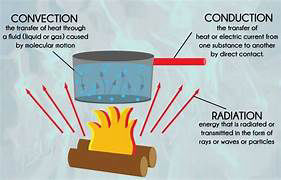
Conduction, Convection, Radiation Story
The Dance of Heat
In the heart of a bustling city, where skyscrapers touched the sky and streets hummed with life, there lived a young inventor named Leo. Leo was fascinated by the invisible dance of heat—the way it moved, transformed, and shaped our world. His tiny workshop was cluttered with gadgets, each designed to explore the mysteries of conduction, convection, and radiation.
The Radiant Lantern
One chilly evening, Leo tinkered with an old lantern. He replaced its oil with a magical liquid that glowed when heated. As he lit the lantern, it bathed the room in a warm, golden light. “Radiation,” Leo whispered, marveling at how light traveled through space without any medium.
The Sizzling Skillet
Next, Leo turned his attention to the kitchen. He placed a skillet on the stove, watching as the metal handle grew hotter. “Conduction,” he declared. Heat flowed from the flame to the skillet, then through the handle, warming his hand. Leo imagined the atoms passing the heat like a relay race.
The Whirling Teapot
Leo’s favorite experiment awaited—a whirling teapot suspended above a candle. As the flame danced, the teapot spun. “Convection,” Leo grinned. The heated air near the flame rose, creating a current. The teapot twirled, its metal sides transferring warmth to the water inside. Soon, steam billowed—a cozy cup of tea in the making.
The Midnight Quiz
Late that night, Leo sat cross-legged, surrounded by his inventions. He posed questions to himself, testing his knowledge:
What causes rising warm air currents?
A. Radiation
B. Conduction
C. Convection
Correct Answer: C. Convection
Explanation: Rising warm air currents involve the transfer of heat through the movement of a fluid (in this case, air). As the air near the surface is heated, it becomes less dense and rises, creating a convection current.
How does a thermometer work?
A. Radiation
B. Conduction
C. Convection
Correct Answer: C. Convection
Explanation: A thermometer measures the expansion or contraction of a liquid (such as mercury or alcohol) due to changes in temperature. When heated, the liquid rises, demonstrating convection.
How is air heated in our atmosphere?
A. Radiation
B. Conduction
C. Convection
Correct Answer: C. Convection
Explanation: Sunlight warms the Earth’s surface, which then transfers heat to adjacent air through conduction. As the air near the surface warms up, it rises, setting off convection.
True or False? The sun directly heats the air in our atmosphere.
A. True
B. False
Correct Answer: B. False
Explanation: The sun heats the Earth’s surface, which, in turn, warms the air through conduction and convection.
And so, Leo continued his experiments, unraveling the secrets of heat. His workshop glowed with curiosity, and the city slept, unaware of the dance that kept them warm—the eternal waltz of conduction, convection, and radiation.